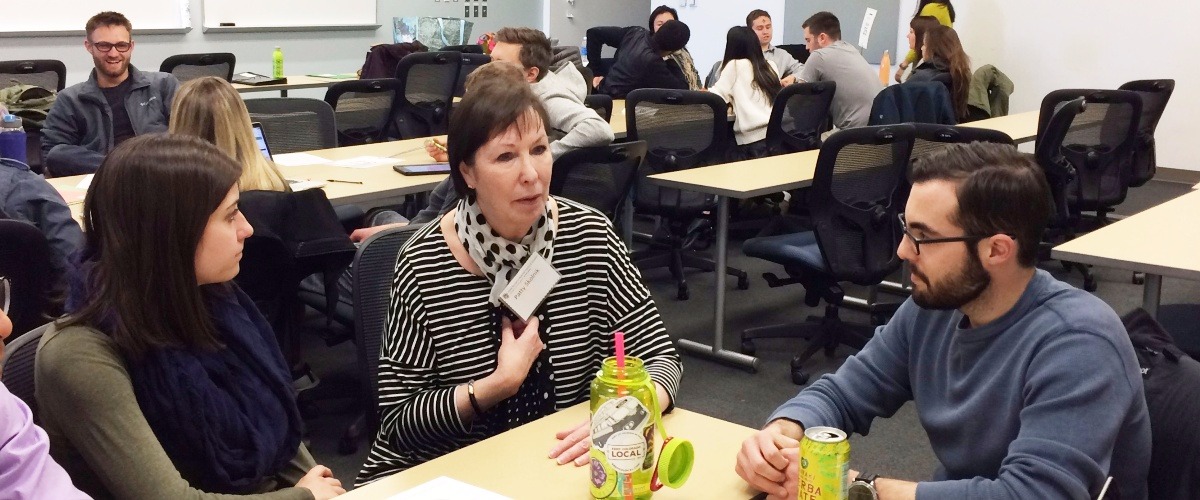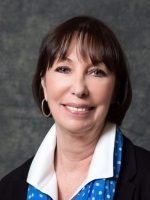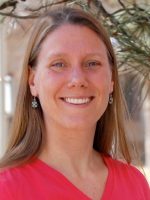 Advocate Patty Skolnik speaks to students in the IPED course.
Advocate Patty Skolnik speaks to students in the IPED course.
On a recent Wednesday afternoon on the Anschutz Medical Campus, students in the Interprofessional Education and Development (IPED) course welcomed some special visitors to their classrooms: patients, acting as advocates, were there to speak about how future health care professionals can empower patients to be health care partners.
More than 700 CU Anschutz students from the Anesthesia Assistant Program, School of Dental Medicine, School of Medicine, College of Nursing, Skaggs School of Pharmacy and Pharmaceutical Sciences, Physical Therapy Program, and Physician Assistant Program met with patient advocates including Patty Skolnik, whose mission comes from a personal passion. She believes that better communication might have saved the life of her only child, Michael.
Skolnik’s presence on campus is the fulfillment of a promise she made to her son Michael, a nursing student who loved working in medicine. She vowed that she would work to improve communication between health care professionals and patients.
“I want patients and their families to know their rights and be presented with options,” she said.
Tragedy turns into a mission of advocacy
In 2001, Michael had a seizure while visiting his parents. On the advice of a neurosurgeon, who thought he saw an abnormality on his brain in a CT scan, Michael had emergency surgery at a community hospital in Colorado, not affiliated with the CU Anschutz Medical Campus. No tumor was found, and he never recovered from the operation. Three years after the surgery, he died.
 Patty Skolnik, founder of Citizens for Patient Safety.
Patty Skolnik, founder of Citizens for Patient Safety.
After Michael died, his case was reviewed, and although the neurosurgeon’s actions were found to be “within the standard of care,” Skolnik believes that the decision to have surgery was rushed in the hectic hours after his seizure. She believes that Michael and the family were not informed of all their available options, including not having surgery.
From this tragedy, Skolnik’s patient advocacy was born. She has testified at the state capitol, been involved in creating legislation to increase transparency about health care and produced PSAs about patient rights. A large part of Skolnik’s work for Citizens for Patient Safety, the organization she founded in 2005 to improve health literacy and empowerment in patients, is visiting medical campuses around the country.
Advocates at Anschutz
[perfectpullquote align="left" cite="" link="" color="" class="" size=""]'I find it empowering to communicate in a team environment that will contribute to providing the best care possible.' - Tanya Gunter, a student in the College of Nursing[/perfectpullquote]
CU Anschutz has made the perspective of patient advocates one of the key components of the curriculum for the IPED course required of students from the anesthesiology assistant, dental, medical, nursing, pharmacy, physical therapy, and physician assistant programs. The class places students in interprofessional teams to review case studies, discuss shared approaches to healthcare, develop teamwork and collaboration skills and have their work reviewed by interprofessional faculty from the health professions programs on campus and community.
“The course is designed to provide experiential learning about the power of teamwork and collaboration while highlighting key principles around roles and responsibilities, values and ethics, quality and safety,” said Suzanne Brandenburg, MD, professor and facilitator for the class that Skolnik visited. “It prepares our students to become effective health care providers in real health care teams.”
The course, which extends over two semesters, also provides students with a new perspective for their future professions: patients as partners working jointly with their health care providers to co-develop a plan for their health care. The course develops this perspective gradually. “Engaging with patients and seeing them as partners in their care is an attitude that needs to be developed over time,” said Wendy Madigosky, MD, MSPH, director of the IPED course.
 Suzanne Brandenburg, MD and facilitator of an IPED class.
Suzanne Brandenburg, MD and facilitator of an IPED class.
The students appreciate the interprofessional experiences that the course offers them. “This course has helped me cultivate respect for the other health professions and how they each work to take care of patients,” said Jessica Smith, a School of Medicine student.
 Wendy Madigosky, MD, MSPH and director of the IPED course.
Wendy Madigosky, MD, MSPH and director of the IPED course.
Empowering students to empower patients
On the day of Skolnik’s visit, student teams, consisting of one student from each school or program where possible, discussed the case study they had been assigned. Each student made suggestions about listening to patient concerns and inviting partnership based on the unique perspective of their field.
“As a future nurse, I find it empowering to communicate in a team environment that will contribute to providing the best care possible,” Tanya Gunter, a student in the College of Nursing, said. “Each member of the patient’s health care team needs to be asking the patient how they feel about their health care plan.”
Jason Platt, a student in the Physical Therapy Program in the School of Medicine, agreed. “Every provider needs to be comfortable encouraging patients to speak up,” he said. “If the patient doesn’t understand, they aren’t empowered.”
At the end of the day, Skolnik reminds the students that their discussions are not just hypothetical. As future health care professionals, they could be her doctor, physical therapist or nurse one day. “This generation of students can change the culture of medicine to one of seeing patients as a resource and a partner,” she said.
[cucalloutbox align="right" color="" class="" size=""]Advocating for Patients Rights: For more information about Skolnik’s advocacy, please visit the website for her organization, Citizens for Patient Safety.[/cucalloutbox]




